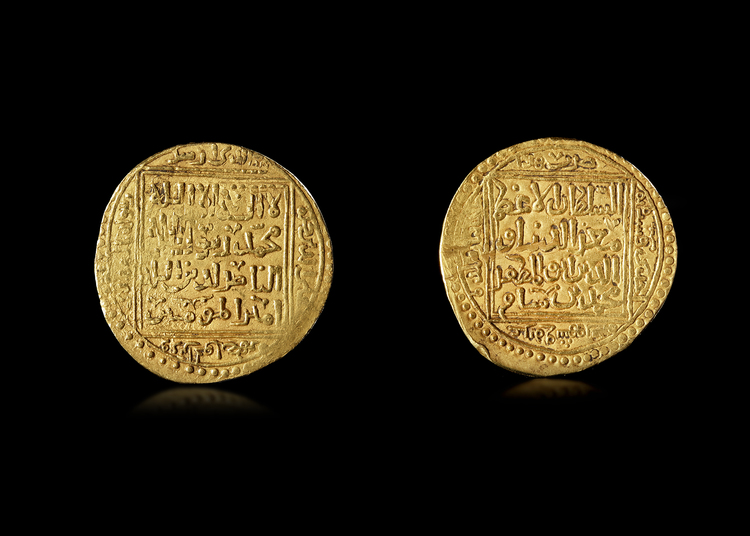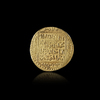A GHURID GOLD DINAR FROM THE REIGN OF MU'IZZ AL-DIN MUHAMMAD B.SAM (567-602AH/ 1173-1206AD) GHAZNA MINT, DATED 601 AH/1204 AD
With square cartouche filled with inscription in naskhi to both sides, the borders with further inscriptions in naskh script, multiple dinar, extremely fine.
The reverse side of the coin is inscribed as ‘La la illa Allah Muhammad Rasul Allah, al Nasir li-Din Allah Amir al muminin’, surrounded by part of v.33 from surah al-Tawbah.
The obverse of this coins is inscribed as ‘‘As Sultan al- Azam Muizz-ud Duniya-wa al-Din Abu al Muzaffar Muhammad bin Sam’ within a square on the obverse side, in margin: mint and date.
Weight: 22.35 gr.
Diameter: 35 mm.
CATALOGUE NOTE
Originally a dynasty of local chieftains from Ghur in the heart of present-day Afghanistan, the Ghurids first come into historical focus during the first decades of the 5th/11th century when Mahmud of Ghazna and his son Mas‘ud launched a series of raids into their territory. By the beginning of the 6th/12th century it was the Great Seljuqs under Sanjar who had become the dominant force in the region, but the defeat of Sanjar in 548h, combined with the decline of the Ghaznavids, left a power vacuum in the region which the Ghurids were well-placed to fill.
Mu‘izz al-Din Muhammad was the younger brother of Ghiyath al-Din Muhammad, and was about 14 years old when his elder brother succeeded Sayf al-din Muhammad as Ghurid Sultan in 558h. Unlike their predecessors, who often fought and feuded among themselves, the two brothers maintained a successful and harmonious partnership which endured for forty years, creating together a vast empire stretching from Northern India to the margins of the Caspian Sea. In 569h they captured Ghazna, which now became Mu‘izz al-Din’s seat, and from where he soon turned his attention to India.
Mu‘izz al-Din’s first raids took him over the Gumal Pass and into the Punjab. He captured Multan and Uch in 570h, and by the late 570s had forced the Sumeras in Lower Sindh to acknowledge him as their overlord. Following a less successful campaign against Gujarat in the West, Mu‘izz al-Din turned next to northern India, eliminating the last of the Ghaznavids at Lahore in 582h. From here he continued down the Ganges Valley and twice fought Prithviraja III, the Chahamana king of Ajmer and Dehli, at Tarain (now Taraori in Haryana). In the first Battle of Tarain in 587h, Mu‘izz al-Din himself was injured and obliged to retreat, but he returned in the following year and won an overwhelming victory on the same field after surprising Prithviraja by attacking before daybreak. Mu‘izz al-Din proceeded to occupy Ajmer where he swiftly moved to establish Islam, replace existing temples with mosques and introducing Islamic precepts and legal principles.
Appointing a local ruler, Govindaraja, to govern Ajmer for him, Mu‘izz al-Din soon left India for Khurasan, where he rejoined Ghiyath al-Din in his struggle against the Khwarezmshah. But his mamluk lieutenants continued to build on his Indian conquests: while he had no sons of his own, Mu‘izz al-Din treated his mamluks as his heirs, giving them excellent training both as soldiers and administrators. Three in particular went on to play important roles in the history of India: Nasir al-Din Qubacha, who became ruler of Multan, Muhammad Bakhtiyar Khalji, who founded the Sultanate of Bengal, and perhaps above all Qutb al-Din Aybak, who established the Sultanate of Dehli.
Ghiyath al-Din died in 599h, and Mu‘izz al-Din succeeded him as sole Ghurid Sultan. He continued to enjoy success in India, where his commander Muhammad Bakhtiyar Khalji became the first Muslim commander to capture Bengal in the year 601h, striking coins in Mu‘izz al-Din’s name to mark this great victory. With the whole of Hindustan now under his control, Mu‘izz al-Din reportedly received the new title al-Sultan al-Sharq, ‘Sultan of the East.’ But his final years were marked by disaster in the West, where the Ghorids suffered a disastrous defeat at the hands of the Khwarezmshahs. Almost the whole of Khurasan was lost, but Mu‘izz al-Din himself managed to reach Ghur where he began to regroup and make preparations for a counter-attack. Before this could be launched, however, he was summoned to India to suppress a revolt. With his Indian domains pacified once more and in the capable hands of Qutb al-Din Aybak, Mu‘izz al-Din set out for Ghazna, but the man who had changed the course of Indian history was assassinated in the Punjab in 602h.



